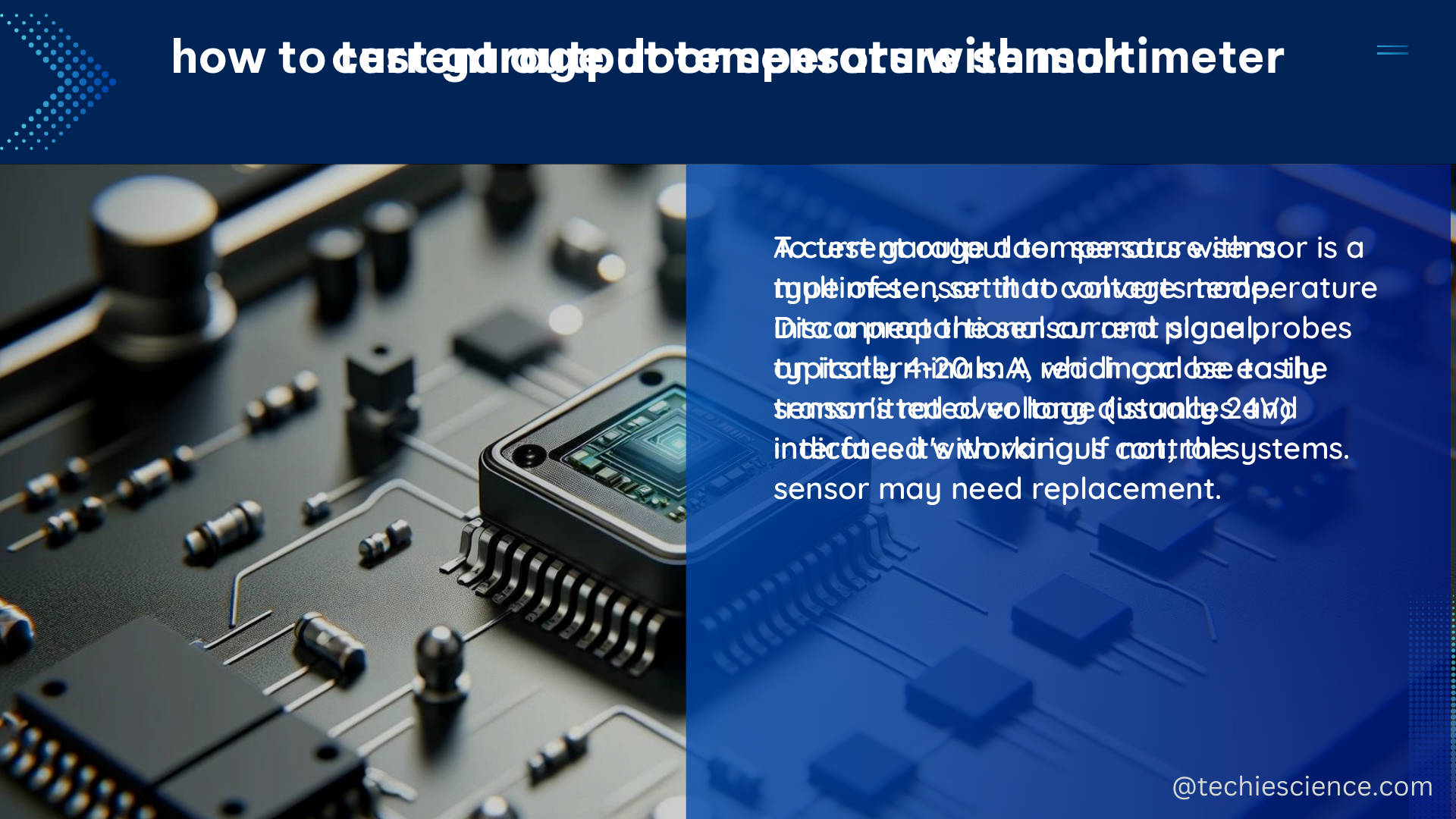The current output temperature sensor is a versatile and reliable device used to measure temperature by converting thermal energy into an electrical signal. This sensor is widely employed in industrial applications where precise temperature monitoring is crucial for efficient and safe operations. By passing a small current through the sensor and measuring the resulting voltage drop, the current output temperature sensor provides an accurate and stable temperature reading, making it an indispensable tool in various industries.
Understanding the Technical Specifications
The technical specifications of the current output temperature sensor are paramount in determining its performance and suitability for a particular application. Let’s delve into the key specifications in detail:
Sensitivity
The sensitivity of the current output temperature sensor is the change in voltage per degree change in temperature. A higher sensitivity means the sensor can detect smaller temperature variations, providing more precise measurements. Typical sensitivity ranges for current output temperature sensors can vary from 1 mV/°C to 100 mV/°C, depending on the sensor type and design.
Temperature Range
The temperature range of the current output temperature sensor is the minimum and maximum temperatures it can accurately measure. This specification is crucial in selecting the right sensor for your application. Common temperature ranges for current output temperature sensors can span from -200°C to 1200°C, with specialized sensors capable of measuring even higher temperatures.
Accuracy
The accuracy of the current output temperature sensor is typically expressed as the maximum error in the temperature reading. This specification depends on various factors, such as the sensor’s sensitivity, temperature range, and the stability of the electrical circuit used to measure the voltage drop. High-precision current output temperature sensors can achieve accuracies as low as ±0.1°C, while more affordable options may have an accuracy of ±1°C or ±2°C.
Response Time
The response time of the current output temperature sensor is the time it takes for the sensor to reach 90% of its final temperature reading after a step change in temperature. This specification is crucial in applications where rapid temperature changes need to be detected, such as in process control or safety monitoring. Typical response times for current output temperature sensors can range from 0.1 seconds to 10 seconds, depending on the sensor design and construction.
Immunity to Electromagnetic Interference (EMI)
One of the unique features of the current output temperature sensor is its relative immunity to electromagnetic interference (EMI). This makes it suitable for use in industrial settings with high levels of electrical noise, where other types of sensors may struggle to provide accurate and reliable measurements.
Applications and Use Cases

The current output temperature sensor finds widespread use in various industrial applications, where precise temperature monitoring is essential for efficient and safe operations. Here are some common use cases:
-
Chemical and Petrochemical Industries: Monitoring the temperature of chemical reactors, distillation columns, and other process equipment to ensure optimal operating conditions and prevent potential hazards.
-
Power Generation: Measuring the temperature of turbine bearings, generator windings, and other critical components in power plants to optimize performance and prevent equipment failure.
-
Aerospace and Automotive: Monitoring the temperature of engine components, brakes, and other systems to ensure proper functioning and prevent overheating.
-
Food and Beverage Processing: Measuring the temperature of food and beverage products during processing, storage, and transportation to maintain quality and safety standards.
-
Pharmaceutical Manufacturing: Monitoring the temperature of production equipment, storage facilities, and transportation vehicles to ensure the integrity of temperature-sensitive drugs and medical devices.
-
Building Automation: Controlling HVAC systems and monitoring the temperature of building spaces to maintain comfortable and energy-efficient environments.
Calibration and Maintenance
To ensure accurate and reliable temperature measurements, the current output temperature sensor must be regularly calibrated. This process involves measuring the voltage drop across the sensor at known temperatures and creating a calibration curve that can be used to convert the voltage readings into temperature readings.
The calibration curve should be updated periodically to account for any changes in the sensor’s sensitivity or other performance characteristics. This can be done by comparing the sensor’s readings to a reference temperature measurement device, such as a calibrated thermometer or a secondary temperature sensor.
In addition to calibration, proper maintenance of the current output temperature sensor is crucial for its long-term performance. This may include cleaning the sensor, checking for any physical damage, and ensuring that the electrical connections are secure and free from corrosion.
Conclusion
The current output temperature sensor is a versatile and reliable device that plays a crucial role in a wide range of industrial applications. By understanding its technical specifications, such as sensitivity, temperature range, accuracy, and response time, users can select the most appropriate sensor for their specific needs. With proper calibration and maintenance, the current output temperature sensor can provide accurate and stable temperature measurements, contributing to the efficiency, safety, and quality control of various industrial processes.
References:
- Temperature Measurement – MST.edu: https://web.mst.edu/~cottrell/me240/resources/temperature/temperature.pdf
- Appendix E: Temperature Measurement System – Lakeshore.com: https://www.lakeshore.com/docs/default-source/temperature-catalog/lstc_appendixe_l.pdf?sfvrsn=b5177ae1_8
- Detection and quantification of temperature sensor drift using probabilistic neural networks – Sciencedirect.com: https://www.sciencedirect.com/science/article/pii/S0957417422019029
- Thermocouple Calibration and Measurement Uncertainty – Omega.com: https://www.omega.com/en-us/resources/thermocouple-calibration-and-measurement-uncertainty
- Temperature Sensor Accuracy and Calibration – Instrumentation Tools: https://www.instrumentationtools.com/temperature-sensor-accuracy-and-calibration/

The lambdageeks.com Core SME Team is a group of experienced subject matter experts from diverse scientific and technical fields including Physics, Chemistry, Technology,Electronics & Electrical Engineering, Automotive, Mechanical Engineering. Our team collaborates to create high-quality, well-researched articles on a wide range of science and technology topics for the lambdageeks.com website.
All Our Senior SME are having more than 7 Years of experience in the respective fields . They are either Working Industry Professionals or assocaited With different Universities. Refer Our Authors Page to get to know About our Core SMEs.